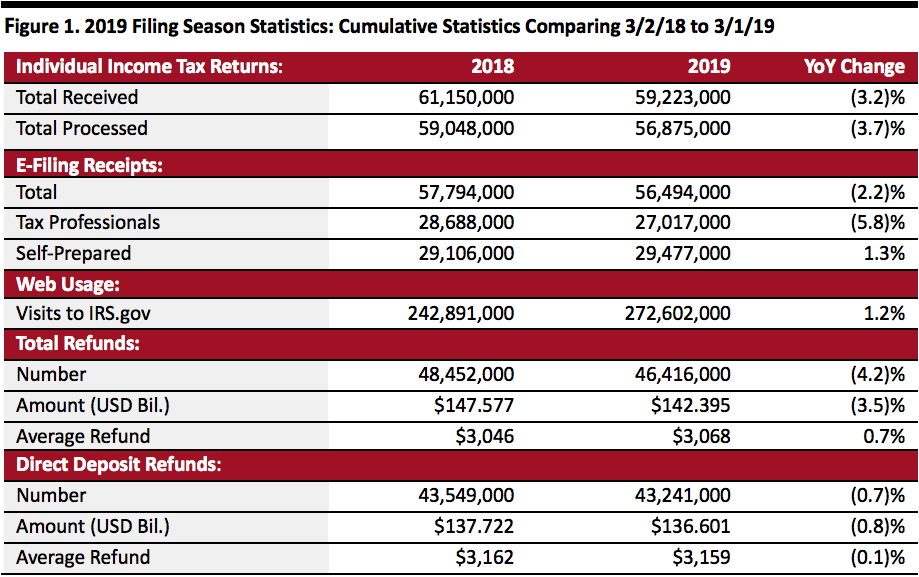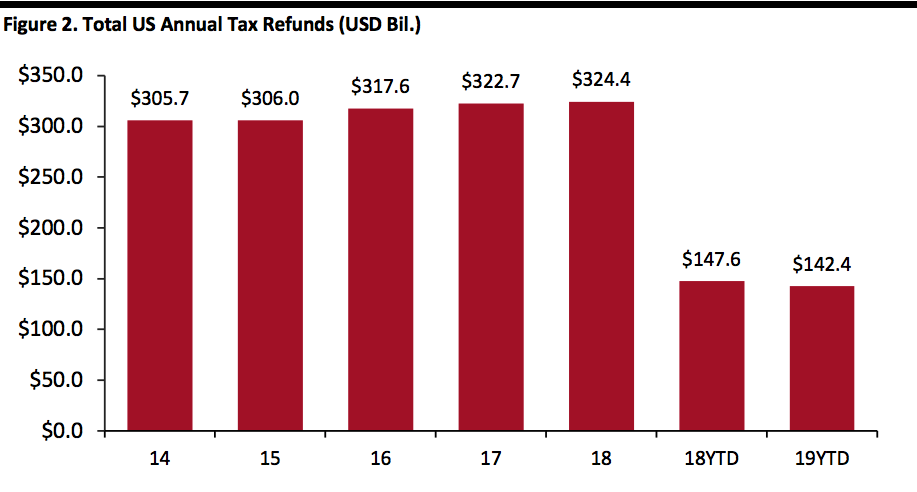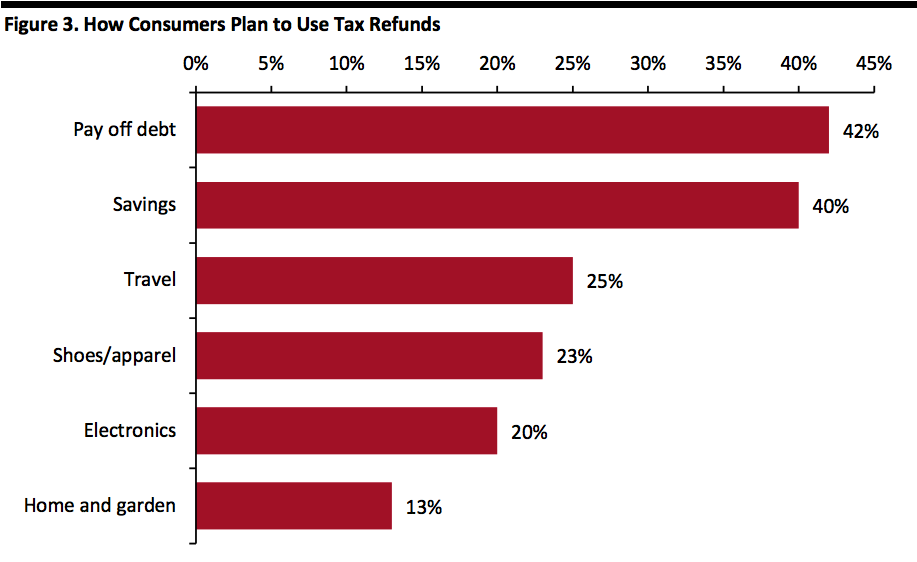Nitheesh NH
Each year, the US Internal Revenue Service (IRS) reports tax return filings and refunds on a weekly basis, starting in February and going into the April 15 filing deadline. It is still early in the filing season, so there will likely be more variability to the data. Filings are likely delayed due to confusion over the new tax rates and the government shutdown, which made it difficult for accountants to get answers to help people prepare income tax returns. The year-over-year decline in the number of filings has moderated, indicating that tax filings are catching up.
As of March 1, 2019:
 Source: IRS[/caption]
Given a solid US economy, higher wages and employment rates, total refunds are likely to be higher in 2019, once the disruption from the government shutdown is resolved.
The graph below shows total annual refunds disbursed to consumers, which increased at a 1.5% CAGR during 2014-2018.
[caption id="attachment_80001" align="aligncenter" width="620"]
Source: IRS[/caption]
Given a solid US economy, higher wages and employment rates, total refunds are likely to be higher in 2019, once the disruption from the government shutdown is resolved.
The graph below shows total annual refunds disbursed to consumers, which increased at a 1.5% CAGR during 2014-2018.
[caption id="attachment_80001" align="aligncenter" width="620"] Source: IRS[/caption]
Taxpayer Survey Emphasizes Debt Repayment, Savings
Website Decluttr recently surveyed consumers’ plans for tax refunds. The top answer was paying off debt, with many respondents alarmingly saying they intend to use their refunds to pay rent or utility bills. The results of the survey follow:
[caption id="attachment_80002" align="aligncenter" width="620"]
Source: IRS[/caption]
Taxpayer Survey Emphasizes Debt Repayment, Savings
Website Decluttr recently surveyed consumers’ plans for tax refunds. The top answer was paying off debt, with many respondents alarmingly saying they intend to use their refunds to pay rent or utility bills. The results of the survey follow:
[caption id="attachment_80002" align="aligncenter" width="620"] Source: Decluttr[/caption]
Source: Decluttr[/caption]
- The IRS had received 59.2 million tax returns and processed 56.7 million of them. The number of returns received was down 3.5% from the corresponding date a year ago.
- Of the returns filed, 95.4% were electronically filed. Of those, 47.8% were prepared by tax professionals, the remaining 52.2% were self-prepared.
- More people are now using the IRS website to get information: the site logged about 272.6 million visits, up 12.2% from the year-ago period.
- A total of 46.4 million refunds had been issued as of March 1, totaling $142.4 billion and averaging $3,068 each, up $22 from a year ago. The number of refunds issued was down 4.2% and the total amount refunded is down 3.5% year-over-year, and the average refund is up 0.7%.
- Of those refunds issued, 93.2% were paid using direct deposit. The average direct deposit refund was $3,139, down 0.1% from the corresponding date last year.
 Source: IRS[/caption]
Given a solid US economy, higher wages and employment rates, total refunds are likely to be higher in 2019, once the disruption from the government shutdown is resolved.
The graph below shows total annual refunds disbursed to consumers, which increased at a 1.5% CAGR during 2014-2018.
[caption id="attachment_80001" align="aligncenter" width="620"]
Source: IRS[/caption]
Given a solid US economy, higher wages and employment rates, total refunds are likely to be higher in 2019, once the disruption from the government shutdown is resolved.
The graph below shows total annual refunds disbursed to consumers, which increased at a 1.5% CAGR during 2014-2018.
[caption id="attachment_80001" align="aligncenter" width="620"] Source: IRS[/caption]
Taxpayer Survey Emphasizes Debt Repayment, Savings
Website Decluttr recently surveyed consumers’ plans for tax refunds. The top answer was paying off debt, with many respondents alarmingly saying they intend to use their refunds to pay rent or utility bills. The results of the survey follow:
[caption id="attachment_80002" align="aligncenter" width="620"]
Source: IRS[/caption]
Taxpayer Survey Emphasizes Debt Repayment, Savings
Website Decluttr recently surveyed consumers’ plans for tax refunds. The top answer was paying off debt, with many respondents alarmingly saying they intend to use their refunds to pay rent or utility bills. The results of the survey follow:
[caption id="attachment_80002" align="aligncenter" width="620"] Source: Decluttr[/caption]
Source: Decluttr[/caption]